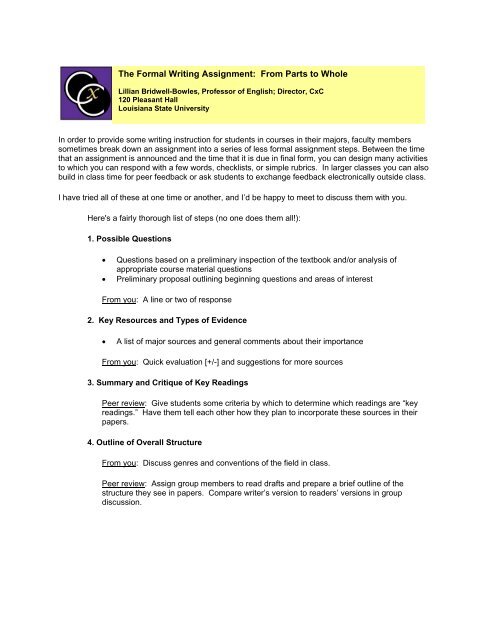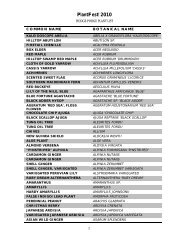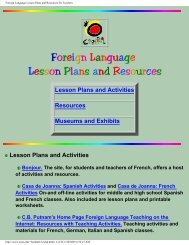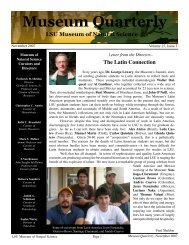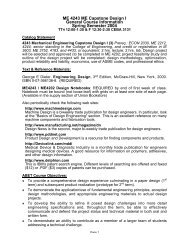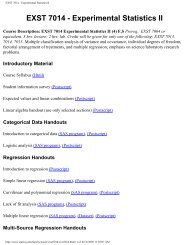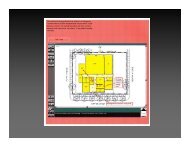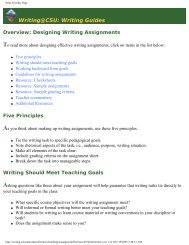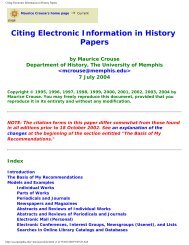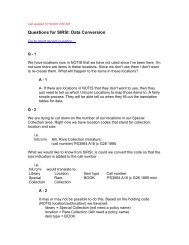The Formal Writing Assignment: From Parts to Whole
The Formal Writing Assignment: From Parts to Whole
The Formal Writing Assignment: From Parts to Whole
Create successful ePaper yourself
Turn your PDF publications into a flip-book with our unique Google optimized e-Paper software.
<strong>The</strong> <strong>Formal</strong> <strong>Writing</strong> <strong>Assignment</strong>: <strong>From</strong> <strong>Parts</strong> <strong>to</strong> <strong>Whole</strong><br />
Lillian Bridwell-Bowles, Professor of English; Direc<strong>to</strong>r, CxC<br />
120 Pleasant Hall<br />
Louisiana State University<br />
In order <strong>to</strong> provide some writing instruction for students in courses in their majors, faculty members<br />
sometimes break down an assignment in<strong>to</strong> a series of less formal assignment steps. Between the time<br />
that an assignment is announced and the time that it is due in final form, you can design many activities<br />
<strong>to</strong> which you can respond with a few words, checklists, or simple rubrics. In larger classes you can also<br />
build in class time for peer feedback or ask students <strong>to</strong> exchange feedback electronically outside class.<br />
I have tried all of these at one time or another, and I’d be happy <strong>to</strong> meet <strong>to</strong> discuss them with you.<br />
Here's a fairly thorough list of steps (no one does them all!):<br />
1. Possible Questions<br />
• Questions based on a preliminary inspection of the textbook and/or analysis of<br />
appropriate course material questions<br />
• Preliminary proposal outlining beginning questions and areas of interest<br />
<strong>From</strong> you: A line or two of response<br />
2. Key Resources and Types of Evidence<br />
• A list of major sources and general comments about their importance<br />
<strong>From</strong> you: Quick evaluation [+/-] and suggestions for more sources<br />
3. Summary and Critique of Key Readings<br />
Peer review: Give students some criteria by which <strong>to</strong> determine which readings are “key<br />
readings.” Have them tell each other how they plan <strong>to</strong> incorporate these sources in their<br />
papers.<br />
4. Outline of Overall Structure<br />
<strong>From</strong> you: Discuss genres and conventions of the field in class.<br />
Peer review: Assign group members <strong>to</strong> read drafts and prepare a brief outline of the<br />
structure they see in papers. Compare writer’s version <strong>to</strong> readers’ versions in group<br />
discussion.
5. Proposal for the Final Paper<br />
• A proposal includes the question or thesis, key resources, and the proposed structure for<br />
the paper—all revised on the basis of feedback in the steps above if you use them.<br />
<strong>From</strong> you: <strong>The</strong> full proposal is the best time for your major time investment. Careful<br />
commentary now will pay off more than commentary on final products at the end when<br />
nothing more than your overall assessment and a grade are at stake.<br />
6. <strong>The</strong> Rough Draft<br />
<strong>From</strong> you or from peers? People are divided about whether it is better for the professor <strong>to</strong><br />
comment on rough drafts or whether peers can do this job well. If peers understand the<br />
criteria and are motivated <strong>to</strong> work collaboratively, they can do a good job. If you have a large<br />
class, you probably have no choice. In my large classes, I have left the job <strong>to</strong> peers, but I’ve<br />
read through all of the drafts and prepared comments on common problems and successes<br />
that I summarize in class time. I use lots of overheads with examples. <strong>The</strong>y know I’ve read<br />
the drafts, but I’ve saved hours because the peers have made the comments on individual<br />
drafts.<br />
To grade or not <strong>to</strong> grade? People are also divided about whether <strong>to</strong> grade the rough draft.<br />
Some say that students won’t invest much if you don’t. This has not been my experience<br />
because I stress that this is the time <strong>to</strong> put the most work forward and get the most feedback<br />
before the grades are at stake. You might have a different experience.<br />
7. Revision of the Rough Draft<br />
Peer review again? If students have worked <strong>to</strong> help each other with the conception and<br />
organization of the draft, they often want <strong>to</strong> meet one more time <strong>to</strong> see the substantive<br />
changes—before they polish and copy-edit the final paper. <strong>The</strong> rationale here is that once it’s<br />
copy-edited, it’s finished! If there are major logical problems or problems with deficient<br />
evidence, for example, it’s better <strong>to</strong> revise before the proof-reading stage.<br />
8. Editing and Proofreading of Final Draft<br />
• Editing of draft for style, structure, mechanics<br />
Final Peer Review (optional; might be done in one stage with substantive comments, editing,<br />
and proofreading concerns discussed in one meeting—see comment above)<br />
9. Final Paper and Self-Evaluation: "What I would do if I were <strong>to</strong> revise this paper…"<br />
• One-page memo, turned in with paper. Could include evaluation of peer review group.<br />
<strong>From</strong> you or your assistants: In smaller classes, I have given a “critic grade” <strong>to</strong> give students<br />
credit for their comments on others’ drafts, and I use this information (along with observation)<br />
when I give them this grade. In larger classes, if peer group meetings take place in recitation<br />
sections, the teaching assistants have evaluated peer review groups.<br />
<strong>From</strong> you: Brief summary comments, perhaps a grading rubric, and a grade.


